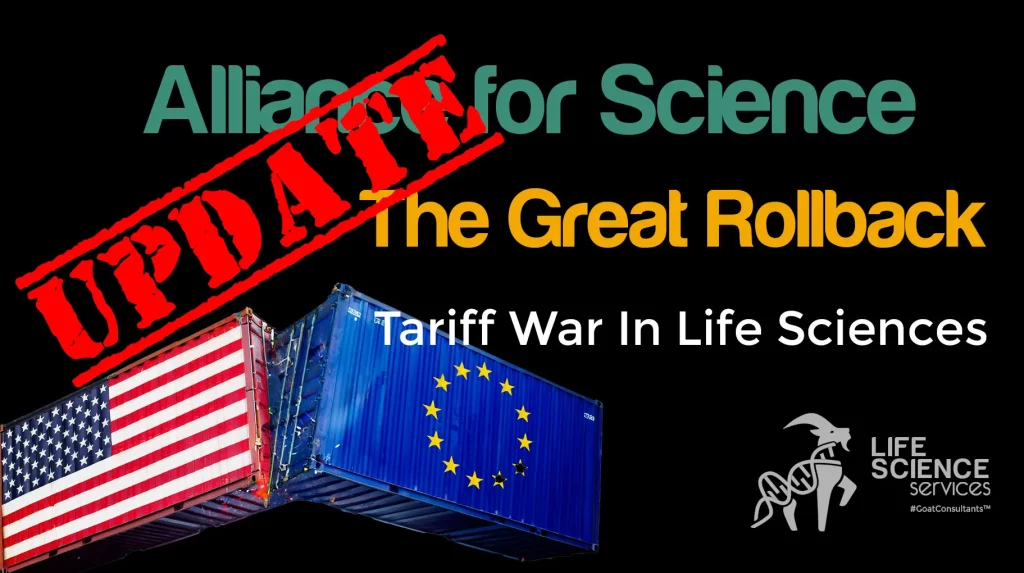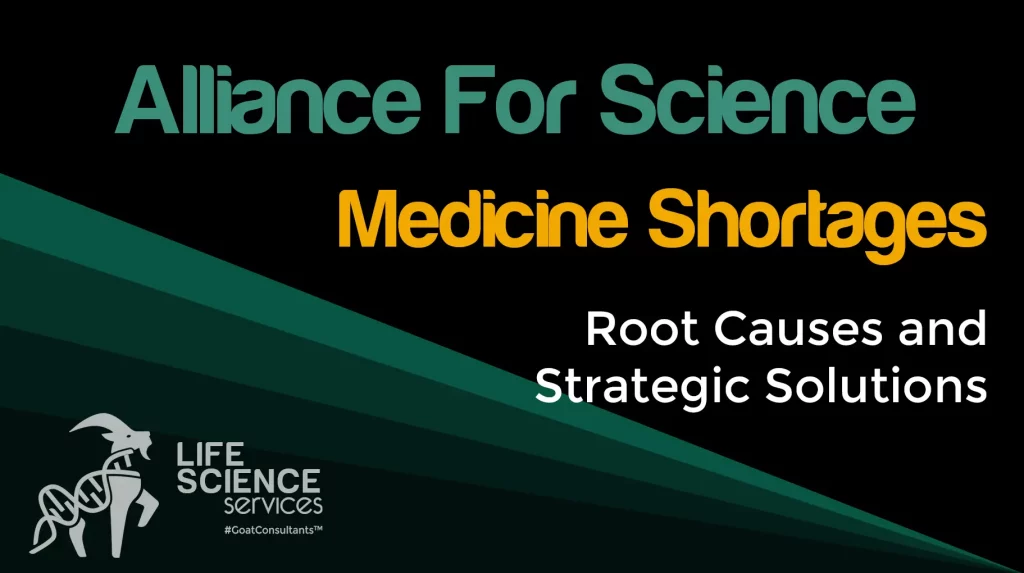Latest News On Tariffs In Life Sciences

The latest news on tariffs in life sciences reveals rising costs, policy risks, and innovation threats. Here’s what executives must know, and do, to stay ahead.
Trump’s Biotech Policy Is Reshaping Global Science and Pharma Supply Chains

Trump’s biotech policy is reshaping global pharma through tariffs, pricing reforms, and reshoring mandates. It is forcing life sciences leaders to rethink innovation, supply chains, and strategy.
Tariff Exemptions in Life Sciences – A Closer Look at the April 2025 Update

🚨 Tariff Exemptions in Life Sciences
❌ Trade policy is failing U.S. pharma & biotech manufacturing.
✅ 60% of pharma inputs & medicines are now tariff-exempt.
❌ But when considering the entire life sciences industry, that number drops to 40%.
🔻 What’s missing?
❌ Medical devices are NOT included.
❌ Manufacturing equipment (CAPEX) is still taxed.
❌ Key biomanufacturing consumables face tariffs.
💡 The biggest contradiction?
Trump’s administration says it wants to “re-arm” U.S. industry—but tariffs still apply to the equipment needed to manufacture medicines here.
👉 How can companies bring production back if CAPEX remains expensive?
📢 What needs to change?
🔹 Exempt medical devices & biotech consumables.
🔹 Eliminate CAPEX tariffs to allow true reshoring.
🔹 Create a comprehensive trade policy for ALL life sciences.
Right now, this isn’t an industrial revival—it’s a half measure.
Licensing Agreements In Life Sciences Amidst Trade Wars and Regulatory Shifts

The Great Rollback is disrupting licensing agreements in life sciences as trade wars and regulatory fragmentation create uncertainty. FDA instability is delaying approvals, causing licensing disputes, while U.S. export controls are forcing European biotechs to reconsider partnerships. To mitigate risks, companies are embedding ‘trade war triggers’ and arbitration clauses in agreements. Meanwhile, the EMA’s regulatory stability offers a strategic advantage, enabling U.S. and Chinese firms to prioritize Europe for faster approvals and market entry. The future of licensing will depend on adaptability, geopolitical foresight, and leveraging EMA’s reliability.
Tariff War In Life Sciences: How to Manage Customs Risks and Costs

The U.S.-EU tariff war is raising costs and tightening customs scrutiny for pharmaceuticals, medical devices, and IMPs. With 25% tariffs on exports, companies can no longer rely on nil-value declarations for clinical trial shipments, risking higher costs, delays, and compliance issues. To navigate this, firms must adopt ERP-driven customs management, ensuring accurate HTS classification, tariff tracking, and duty mitigation to protect supply chains and control costs.
Medicine Shortages in the EU: Root Causes and Strategic Solutions

Medicine shortages in the EU are not a new challenge, yet they continue to disrupt healthcare systems and patient care worldwide. Over 50% of these shortages stem from manufacturing and quality issues, exacerbated by fragmented supply chains, inadequate data management, and reactive crisis handling.
This article dissects the root causes of medicine shortages and offers practical, data-driven solutions for life sciences companies. From strengthening supply chain resilience to leveraging modern ERP systems for early risk detection, we explore how small and mid-tier pharma companies can move from crisis response to proactive prevention.
The key to solving medicine shortages? Organized data, structured processes, and strategic action. Read on to discover how the right approach can transform uncertainty into stability.
Key Financial Focus for Life Sciences in 2025: The Five Pillars of Financial Excellence

In 2025, finance teams in small and mid-tier life sciences companies are transitioning from traditional roles to become enablers of innovation. This evolution is guided by five key pillars:
1. Capital Allocation: Prioritizing strategic planning to balance cost efficiency with investment in high-return areas, ensuring sustainable growth.
2. Diversifying Revenue Streams: Reducing reliance on single income sources by exploring licensing deals, partnerships, and geographic expansion to mitigate market volatility.
3. Mergers & Acquisitions Trends: Adapting to M&A landscapes influenced by GenAI and ESG priorities, requiring agile strategies and leveraging niche expertise to stay competitive.
4. Regulatory and ESG Compliance: Proactively integrating stringent regulatory requirements and robust ESG practices to build trust and long-term value.
5. Digital Transformation and AI: Embracing AI-driven insights and automation to eliminate inefficiencies, allowing finance teams to focus on strategic initiatives.
By focusing on these pillars, finance teams can effectively navigate the evolving landscape of the life sciences industry in 2025.
Leveraging Digital Transformation and AI for Financial and Operational Efficiency in 2025

In 2025, digital transformation and AI are fundamentally reshaping financial and operational landscapes in the life sciences sector. CFOs and executives in pharma, biotech, medtech, and biopharma are adopting strategic approaches to navigate these changes effectively. Key priorities include automating routine tasks to free up resources for strategic activities, leveraging real-time data analytics for informed decision-making, integrating cloud-based ERP solutions with AI tools for scalability and continuous innovation, and enhancing cybersecurity measures to protect sensitive data. Effective data management is crucial, as AI’s success depends on accurate, complete, and structured data. Investing in robust data governance frameworks ensures data quality and integrity, positioning businesses for long-term success in this evolving landscape.
Future of Healthcare 2025: Mastering Regulatory Landscapes

Regulatory shifts and ESG integration are reshaping life sciences. The EU Data Act (Sept 2025) mandates easier access to user-generated data, while the Biotech Act enforces stricter guidelines for gene therapy and personalized medicine in both the EU and US. ESG principles are now essential for investor trust and long-term growth. To stay competitive, companies must embrace compliance, sustainability, and digital transformation.
How Small and Mid-Tier Life Sciences Companies Can Shape M&A Trends in 2025

In 2025, small and mid-tier life sciences companies are significantly influencing mergers and acquisitions (M&A) by leveraging innovation, flexibility, and niche expertise. These agile firms excel in developing cutting-edge therapies and technologies, particularly in specialized markets like rare diseases and personalized medicine, making them attractive partners for larger organizations. Their ability to adopt creative deal structures, such as revenue-sharing models and joint ventures, allows for scalable growth without full integration. Additionally, the use of AI-driven tools in due diligence processes enhances transparency and accelerates deal execution, setting new industry standards. By embracing these strategies, small and mid-tier companies are not only attracting lucrative deals but also redefining M&A dynamics in the life sciences sector.
Diversifying Revenue Streams Beyond Core Products

In an increasingly competitive life sciences landscape, CFOs of small and mid-cap pharma and biotech companies are strategically diversifying revenue streams to address patent cliffs and market uncertainties. This shift goes beyond risk mitigation to ensure sustainable growth and innovation. From digital health technologies to strategic alliances, diversification has become critical for success in 2025. Companies are moving beyond traditional drug development to explore digital therapeutics, AI-driven diagnostics, and personalized medicine solutions. This evolution is especially vital for smaller players competing with larger pharmaceutical companies. Through diversification, companies protect against market volatility while driving healthcare innovation. Digital technologies and strategic partnerships create new opportunities in the evolving healthcare landscape.
Capital Allocation and Cost Efficiency in Life Sciences

Small and mid-cap life sciences companies face mounting pressures in 2025. With increasing market volatility, limited resources, and fierce competition, many CFOs are struggling to direct capital allocation and cost efficiency effectively. Inefficient capital allocation not only slows innovation but can also lead to missed growth opportunities, delayed product launches, and financial instability. If left unresolved, these challenges could jeopardize strategic priorities, reduce shareholder confidence, and compromise long-term sustainability. For companies in biotech, pharma, and biopharma, the stakes are especially high as competition intensifies and access to funding tightens. CFOs must act decisively to align resources with business goals and ensure efficient financial operations.
The Value of Your Company Unveiled Thanks to Modern ERP Financial Reporting

In small and mid-cap life sciences companies, finance teams are stuck in legacy accounting practices that stifle innovation. Bloated Excel sheets, convoluted explanations, and feedback loops that feel more like interrogations leave R&D teams frustrated and distracted. These outdated processes don’t just waste time—they erode the value of R&D itself. It’s time for non-finance leaders to demand streamlined, transparent tools that support growth, not block it.
As a result, the journey from lab to market hinges on the seamless integration of R&D with strategic financial oversight.
Below, we explore why CFOs – and stakeholders – must rethink their approach, replacing outdated methods with more modern and integrated solutions to protect and amplify R&D success.
Outdated Accounting Practices Hold Back R&D Success

In small and mid-sized life sciences companies, outdated accounting methods in finance are causing more harm than meets the eye. Legacy systems—marked by complex Excel spreadsheets and lengthy feedback loops—are overwhelming R&D teams. These inefficient practices waste time and drain the value of R&D, leading to delays in innovation. It’s time for non-finance leaders to push for streamlined, transparent accounting tools that drive progress rather than hinder it. The path from lab to market depends on integrating R&D with modern, strategic financial oversight. CFOs and stakeholders must embrace up-to-date, integrated solutions to secure R&D success and company growth.
Outdated Accounting Processes Hinder Revenue Recognition Efficiency

Outdated accounting processes in small and mid-sized life sciences companies significantly hinder revenue recognition efficiency. Reliance on legacy systems and manual methods leads to inaccuracies and delays, especially when scaling operations. To address these challenges, companies should modernize their financial processes by implementing advanced ERP systems and adopting automation. These changes will improve accuracy, efficiency, and scalability, ensuring compliance with revenue recognition standards like ASU 2014-09 and IFRS 15. By upgrading systems, companies can streamline revenue recognition, ensure compliance, and drive growth. 
Chaos or Catastrophe? BREXIT Transition ends on 31 December 2020

With less than a month to go (date of writing 1-Dec-2020) until the end of the post-Brexit transition period, there’s still no clarity about exactly how the UK’s borders will operate outside the EU’s economic zone – the single market and the customs union. There is still no trade deal between the UK and the EU and such agreement will take years to be concluded. In the meantime, businesses that trade across the border are extremely concerned as it is likely that widespread disruption will happen as of 1 January 2021. It is one of the reasons of why MHRA has approved the vaccine (link here) as shipments will be authorized as of today (origin Belgium) and thus avoid delays. Because from 1 January 2021, trading, inbounds and outbounds, will face large amounts of new paperwork and checks that includes: In order to limit the disruption of the trade, UK government has decided to postpone customs checks until 1 July 2021 leaving some additional time for companies to prepare. But the scale of complexity due to paperwork cannot be underestimated and it is expected that January 2021 will be a difficult month for customs clearance. We prepared the below document to help you understand the changes that will affect your movement of goods with the UK (England, Scotland and Wales – Northern Ireland is a different category). DOWNLOAD ⤵️
What is Shadow Payroll?

Today’s workforce is mobile, and COVID-19 pandemic has accelerated this trend. France, Italy, Germany and even Belgium, Netherlands and UK… It is not unusual to hear that people returned to their home country and are working remotely. Can this practice have an impact on companies and the way payroll is handled? Yes, it does. As the current situation may last longer than expected, if a company has employees working from a different country they have to be considered as “expats”. Nations are more demanding and local tax jurisdictions are increasing pressure on people’s income tax and shifting the burden of taxation to employers, many things can go wrong for companies which will be required to pay heavy fines. Let’s use the following example: “Max is British. He lives in Basel and works for a Swiss based pharma company (home country). In March 2020, because of the COVID-19 pandemic, Max decides to work from his home in the UK (host country), and travel to Switzerland when required , usually one day per month for on-site meetings. Max’s plans are to return to Switzerland when his company’s office opens again, which is planned in March 2021.” How shall this case be treated? Generally, double taxation treaties apply for assignments that are less than 6 months. As the stay is longer than 183 days, it is considered a long-term assignment and Max’s income may be subject to tax in the host country (UK). In this case Max’s company is required to implement a shadow payroll and pay for the social security in the host country. What is Shadow Payroll? Shadow payroll is a method to assist and comply with international payroll and tax regulations while an employee has a different host country. As the payroll is shadowed in the host country, it generally requires the home country company to register as taxpayer in the host country or to have a local subsidiary or branch to be registered. It is a complex process, which requires detailed knowledge and expertise! For further information, please:
Future Tax Policy for Digital Economy

The digitalization of the economy remains an important tax challenge and was identified as an area of focus of the Base Erosion and Profit Shifting (BEPS) Action Plan. With the objective to change the actual profit allocation rules for digital companies two Pillars were identified: Grouped under an Inclusive Framework (“IF”), the Program of Work (“PoW”) was initiated in May 2019 by the G20 ministers jointly with the OECD. Following several revisions, the IF and OECD adopted a consensus based solution on Pillar One: the “Unified Approach”. On January 31, 2020, the OECD endorsed the Pillar One and approved to negotiate its principles under the Unified Approach which is intended to be finalized by 2020. The proposal would have to be adopted by the G20 before getting implemented in the various jurisdictions. The concept is to design a solution that attracts support from all members of the Inclusive Framework. The Secretariat’s proposal for a “Unified Approach” has been developed with this goal in mind. Key features of a solution, which would include the following: Scope. New Nexus. New Profit Allocation Rule going beyond the Arm’s Length Principle. Increased Tax Certainty delivered via a Three Tier Mechanism. To summarize, reaching a consensus amongst 137 countries participating in the IF is a great challenge, but the IF has already shown a huge determination in bringing the Unified Approach in such short notice. In an ever evolving landscape of regulations*, we recommend multinational companies to develop contingency plans, change scenarios and implementation without delay. For further information: simon.massel@lifescienceservices.ch Source: http://www.oecd.org/ *US GOP Tax Reform, the EU Anti-Tax Avoidance Directives (“ATAD I” and “ATAD II”), BEPS Action Plans, Pillars One and Two
COVID-19 Employer Q&A Switzerland

Situation at April 1, 2020 The following lines is an intent to help you navigate to your rights when facing the most commun issues that employers and employees are facing amid the current COVID-19 pandemic. Are my employees obliged to disclose themselves as a risk-factor? Only if they have a confirmed infection. Otherwise no. As an employer can I demand my employees to disclose themselves as risk-factor? Yes, only if you are implementing sanitary measures to protect employees. Questions need to be proportionate in light of the information that the employees need to disclose. Then employees who are at risk can be asked to disclose it to the employer. It can be done by written statement from the employee or the employer may as for a medical certificate. As an employer/manager can I request employees to report co-workers with symptoms of COVID-19? Yes, but this measure can be seen as an obligation to report other employees and the data obtained in the case of a risk-factor person cannot be kept on the personal record of the employee and deleted within 5 weeks. Furthermore, the type of information provided is very important: as an employee I can report that a colleague seems to suffer from a fever, tiredness, etc. But I cannot report that an employee suffers from asthma or any other disease. It would be a violation of privacy and is very sensitive. In addition, a person which was reported has the right to know who the reporter is. It is very important to think how to address this situation. Finally, you may inform other employees in a timely and transparent matter, with the appropriate level of information as explained here; only relevant information can be disclosed. As an employer can I require that my employees see a doctor? Yes, but at the employer expense. Furthermore, the doctor is not allowed to provide details to the employer. The only information the doctor can provide is if the employee is able to work or not. One of my employees is refusing to come to work. Can he do that? At-risk employees can ask to work from home provided that it is possible from a technical and operational point of view. If work activities can only be carried from the usual place of work, employers must be fully compliant with the federal recommendations on hygiene and social distancing for all employees. The same applies if an important meeting is taking place and for business trips. My company is not on the list of companies that must shut down operations, but I want to shut it down anyway. Can I do it? In the case of a voluntary shut down, the employer must pay the full salary to its employees. Do I have to pay an employee who can’t work because kindergartens and schools are closed, and the employee must stay at home to look after his/her child(ren)? Employees will receive their full salary for the first three days of absence. As of the fourth day the employer does not have to pay any salary. Employees might qualify for a daily allowance equal to 80% of their salary, with a cap of maximum 196.00 CHF per day. The employee is responsible for the application with the social security fund of the company. Generally, if an employee is prevented from working because of an act of negligence from his part (travel to prohibited areas, breach of confinement, etc.) he/she is not entitled to receive any salary pay. The chart below summarizes your rights and obligations. We hope this article is helpful. Rui M. Teixeira
